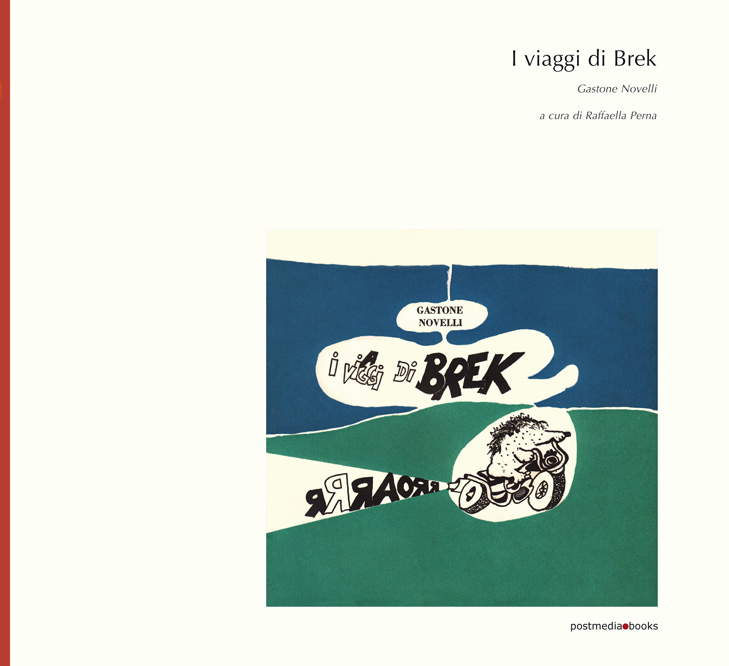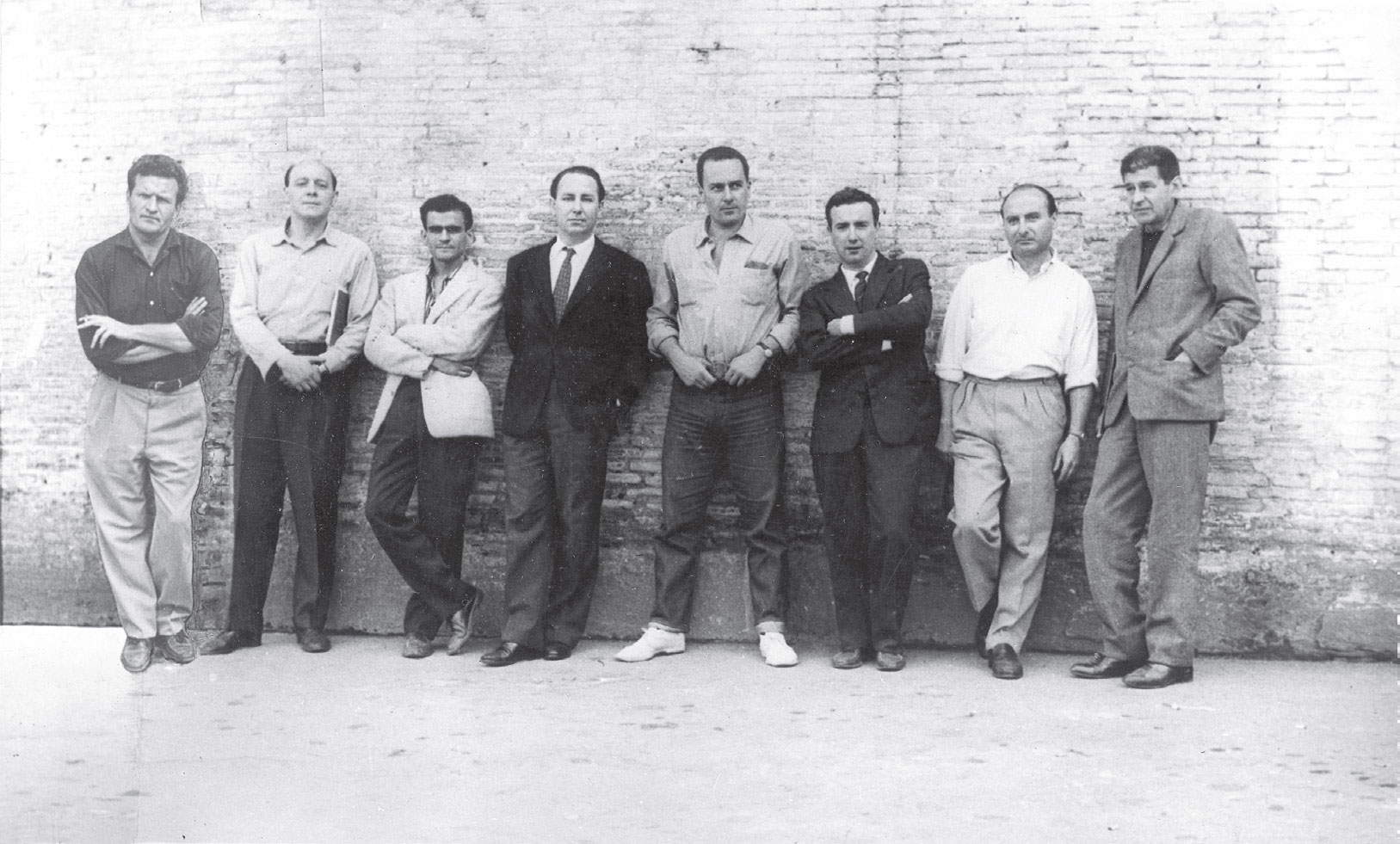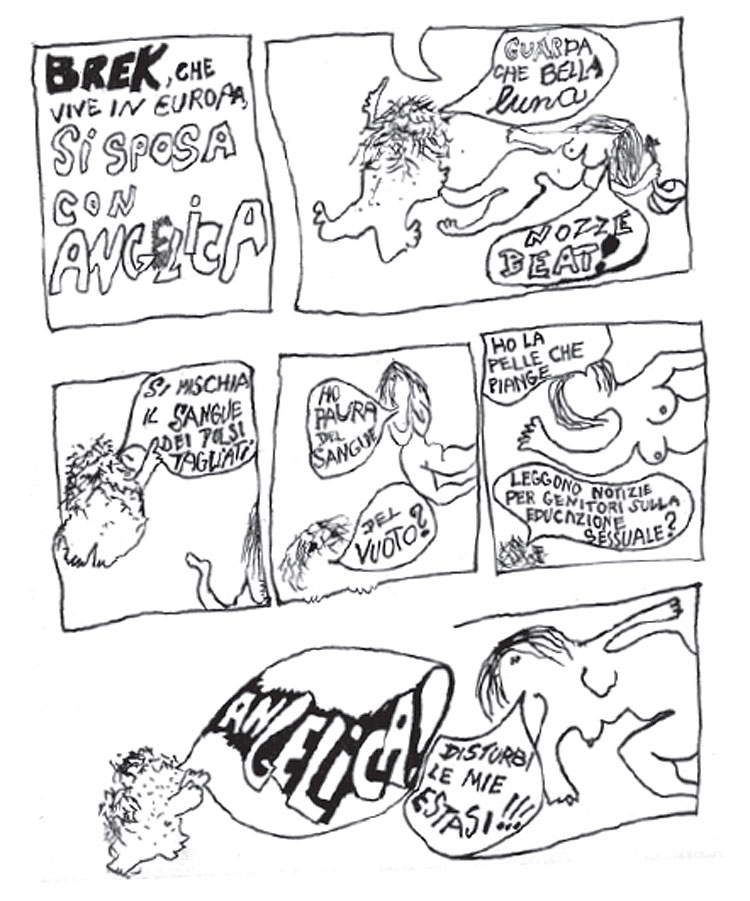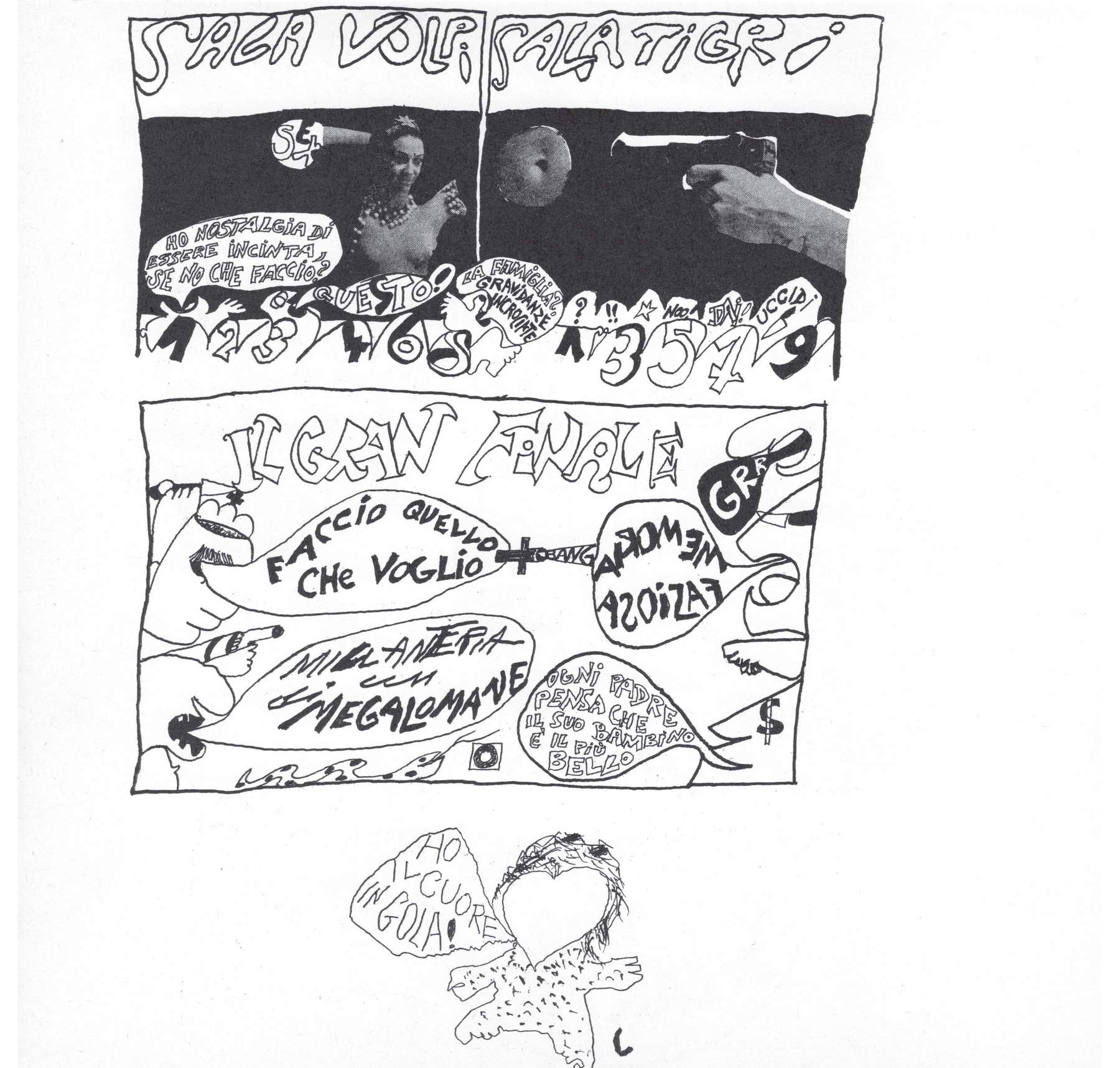Fifty-four years after their publication with the publisher Alfieri in 1967, I viaggi di Brek by Gastone Novelli (Vienna, 1925 - Milan, 1968), the pioneering (and forgotten) comics of the great avant-garde artist, are back available to the public in 2021, thanks to a meritorious work involving multiple subjects: the book thus lives again in a brand new limited edition from Postmedia Books (only 199 copies), edited by Raffaella Perna in collaboration with theGastone Novelli Archive, and published in the series Quaderni della Fondazione Echaurren Salaris. Brek’s Travels represented Novelli’s most significant foray into the world of comics: his interests in bandes dessinées go back as far as the 1950s, although it was not until 1960 that this fascination found better codified structures (albeit not universally shared: at the time, in Italy, comics were looked upon primarily as a mode of expression intended for childhood, and few were willing to pay a different kind of attention to it). In fact, it was in that year that Novelli joined the Crack group, together with Pietro Cascella, Piero Dorazio, Gino Marotta, Fabio Mauri, Achille Perilli, Mimmo Rotella and Giulio Turcato, gathered around the critic Cesare Vivaldi, and it was, in particular, thanks to his contact with Mauri and Perilli that Novelli deepened the possibilities of comics as a means of artistic expression.
Mauri, in an entirely independent and autonomous way from what was happening in the United States, where the works of Roy Lichtenstein would establish without appeal the artistic dignity of comics, found in Comics a chosen terrain for his own research: research that is linked, writes Raffaella Perna in the unpublished essay published in the Postmedia Books edition of I viaggi di Brek, “to childhood memories, to the interweaving of personal and collective memory” and is imbued with “affective components and diaristic elements.” Novelli’s paintings of these years include elements derived from his study of comic books: squared-off boxes, layouts similar to that of cartoonists’ plates, a more pronounced narrative tendency. In contrast, his first elaboration of a comic strip strictu sensu dates from 1964: that year, at the height of the exchanges between the artists of the Crack group and the literati of the Group 63 group (from which the artist takes the tendency to proceed by imaginative and sudden associations, the disjointed writing, the absence of apparent connections between the different elements of the work’s structure), Novelli published Nel cieco spazio, a work that already contains many of the elements that will also characterize The Travels of Brek, namely, Perna writes, “the narrative disarticulation, the primordial and nervous character of the drawing, the lack of logical correspondence between image and word, the co-presence of different lilnguistic registers,” all aspects that “give the strips an alienating quality, in antithesis with the canonical structure of the comic strip.” The time is thus ripe for the publication of The Travels of Brek.
 |
| Cover of I viaggi di Brek by Gastone Novelli (Postmedia Books, 2021, orig. ed. 1967) |
 |
| Gastone Novelli in 1966. Photograph by Marina Lund |
 |
| Artists of the Crack group in Piazza del Popolo, Rome 1960, from left: Pietro Cascella, Piero Dorazio, Gino Marotta, Fabio Mauri, Gastone Novelli, Achille Perilli, Mimmo Rotella, Giulio Turcato. |
The Milanese artist presents his work for the first time by exhibiting the 25 plates of which it is composed at the Galleria dell’Oca in Rome, before an audience that also includes, among others, Pier Paolo Pasolini and Laura Betti. A forerunner of today’s graphic novels, I viaggi di Brek (Brek’s Travels ) features Brek as its protagonist, a funny, unidentified little furry monster whose name is reminiscent of an onomatopoeic sound (or rather, to use the words Novelli himself uses to introduce his anti-hero in the first panel of the strip novel: “a sound that allows you to interrupt a boring conversation”). Brek is a sort of 1960s Orlando, complete with Angelica (the “beat marchioness of the Angels,” with reference to the Marquis De Sade, the Hell’s Angels and the counterculture that constitutes the visual and cultural foundation of many elements of the work, starting with the lettering), whom, however, the protagonist, unlike his Ariosto counterpart, marries immediately, in the opening of the story, and then consummates a listless intercourse in front of the television. Boredom soon prevails, however, and Brek decides to embark on a journey around the world: he is first in Texas, where he is badly hunted by the local police. Then he is in New York, where he suffers prejudice and racism and is finally unceremoniously deported.
Returning home, he finds Angelica in companionship with “Manga,” a large octopus who speaks in maxims (and who in his approach to Angelica is reminiscent of the octopus in Hokusai’s Dream of the Sailor’s Wife ): tired of hearing this, Brek sets off for the moon, but even this experience will be disappointing, for he will be hunted by the satellite as well. He then decides to find refuge with a psychoanalyst, Dr. Nimbus, to whom the little monster confides his problems and anxieties, beginning with the fact that Angelica is leaving him for a marine captain. In the face of the specialist’s merciless diagnoses, however, Brek escapes and finds himself at the Venice Film Festival: eventually, dazed, the strange creature will end up embracing Maoism, waving the Little Red Book and speaking through Mao’s aphorisms on the only colored page (red, of course) in the entire work.
Brek’s travels are thus a kind of tale of disorientation, of the frustration of a character who experiences various experiences and finally, dissatisfied, ends up taking refuge inideology, although the jarring between Mao’s bombastic rhetoric (“This world can be transformed only by violence, ”All reactionaries are paper tigers," and so on) and thegrotesque appearance of the little being can only contradict the very assumptions of Brek’s change of orientation and highlight all the limitations of ideologies themselves (despite the fact that Novelli looked with certain interest and conviction to Maoism). Who, then, is Novelli’s Brek? He is, first and foremost, different, as Perna explains: the character’s image, which is close to that of the caveman in Johnny Art’s highly successful comic strip B.C., recalls the concepts of deviance and otherness, and is functional in developing a story that tells “with a critical gaze,” the scholar writes, “the alienation of human relations in the civilization of consumption through the invention of places and characters [...] that constitute an elsewhere from the point of view of space, time and in special world of behavior.” Brek’s elsewhere is provided by his intercontinental and even interplanetary travels, which, however, end up “colliding with despairing realities laden with racism and violence.”
 |
| Tablet from The Travels of Brek |
 |
| Tablet from The Travels of Brek |
 |
| Board from The Travels of Brek |
 |
| Board from The Travels of Brek |
 |
| Tablet from The Travels of Brek |
Brek is then a dissident fully immersed in the reality of ’68, and the references to beat culture can be explained by Novelli’s attitude at the time toward American society: “The United States,” the artist wrote in October 1967, a month before the publication of Brek, “can and must be undermined from within with the continual refusal to accept the rules of the society they represent. The Flower Children are a way of undermining the dollar society.” However, he is also a confused individual, opting in the end for a revolutionary turn perhaps without really being convinced, and almost exclusively for sentimental reasons: one can read between the lines Novelli’s critique of Maoism, who in some of his writings published in 1968 could not help but pronounce himself on the subject of the relationship between art and politics and between artist and society. And writing about Mao, Novelli noted that “a revolution that builds up a literary and artistic heritage by rehypothesizing the forms of the past (born as a product of a feudal or religious or bourgeois society and thus containing its myths, ideas and rules), a revolution that does not produce languages, that does not assimilate the forms that are born in it, is a revolution in the middle.” The structures of a society can thus be transformed only if traditional means of expression are challenged.
Novelli’s comics are characterized, in addition to the formal elements mentioned at the beginning (the nervous sign, the alienating and irregular narrative structure, the lettering that harks back to the psychedelia scene, and then the use of collage, hyperbole, and the convulsive trend of the layout), also by the ability to mix high and low culture: the references range from Tex Willer to Georges Bataille, from Hokusai to the films of Luchino Visconti and Marco Bellocchio, from American erotic B-movies to the poems of Edgar Allan Poe (and it is interesting that republishing this work was the foundation of Pablo Echaurren and Claudia Salaris, that is, an artist who shared with Novelli an interest in comics and the mixing of languages, and an art historian who is a scholar of the twentieth-century avant-garde). This tendency to abolish boundaries is another of the elements that give an account of Gastone Novelli’s experimentalism and his research, in which, Perna further writes, “his reflections on language, on the intersections between painting and writing, his experience in experimental theater and his interest in the new instances expressed by beat culture converge.” Although they are still little known, probably because they were printed at the time in few copies and because they belong to a side of Novelli’s career that was obscure to many, I viaggi di Brek is a visionary product that combines comics and painting, is still one of the highest examples of the graphic novel genre in Italy, represents an important chapter of Gastone Novelli’s production and can help to better understand the multifaceted personality of one of the main protagonists of his time. As well as of one of the first artists to have understood, perhaps even ahead of his time, that comics can speak the language of works of art.
Warning: the translation into English of the original Italian article was created using automatic tools. We undertake to review all articles, but we do not guarantee the total absence of inaccuracies in the translation due to the program. You can find the original by clicking on the ITA button. If you find any mistake,please contact us.